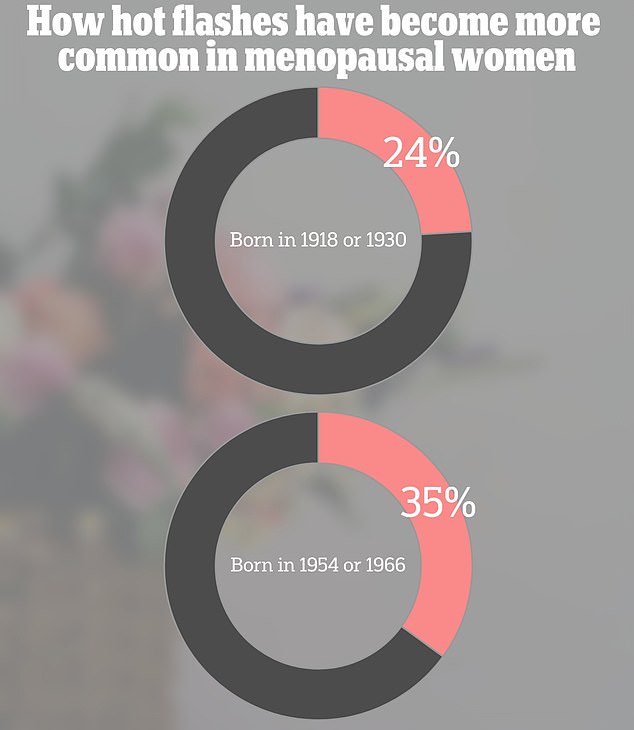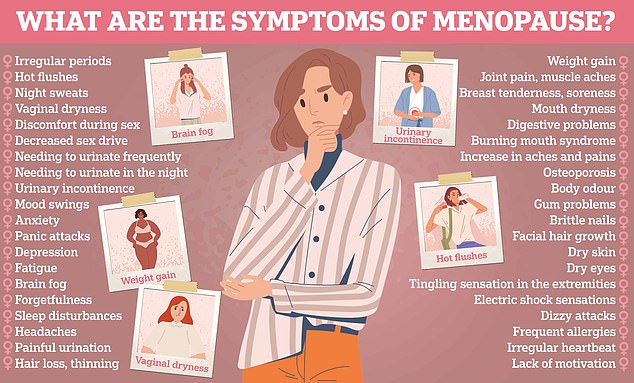More recent generations of women experience menopause differently than those who came before them, including more frequent hot flashes and a longer transition period.
Doctors and data researchers are now coming to the conclusion that a host of factors—obesity, medication use, smoking history, and even environmental pollution—influence how menopause occurs.
Those factors combine to alter the way DNA is expressed in a way that previous generations did not.
For example, people who today live in areas with high rates of air pollution show alterations in the way genes involved in inflammation and cardiovascular disease are expressed that differ from a generation ago.
Women today are also more likely to talk about their symptoms, discuss them with other women, and seek medical treatment, which researchers say could be responsible for the inflated numbers and help explain why women today seem to experience worse transitions.

Women born in 1954 and 1966 were almost twice as likely to experience daily hot flashes at age 50 than women born in 1918 and 1930, regardless of obesity, smoking and stress.


Hot flashes are the most common symptom of menopause, and 75 percent of women experience these sudden, brief increases in body temperature.
Menopause occurs when the ovaries stop producing estrogen, the female sex hormone.
Women are considered menopausal when they have not had their menstrual period for 12 consecutive months, at which point their normal periods stop completely and they can no longer have babies.
Most women experience it between the ages of 45 and 55, but the average age in the United States is 51.
Night sweats and hot flashes are the most commonly reported symptoms, but a large cross-generational study has shown that women born earlier had fewer of them.
He data comes from Sweden, where researchers studied groups of women in their 50s born in 1918 and 1930 (the “earlier-born cohorts”) and those born in 1954 and 1966, the “later-born cohorts.” Those born in the last generation had more frequent hot flashes than those who preceded them.
Even after accounting for smoking history, high levels of perceived stress, body mass index, waist-to-hip ratio, hormone therapy, and hormonal contraceptives, recent birth cohorts were still more likely to experience hot flashes. daily compared to previous cohorts.
It could be because women are more open about menopause in general. This condition has traditionally been seen as a time in a woman’s life when she is no longer vital or attractive.


The menopausal transition usually lasts about 7 years, during which time women can experience a long list of symptoms that go beyond hot flashes and night sweats.
But there are now a growing number of women willing to share their menopause experiences to raise awareness and benefit others who are in the same stage of life transition. With this has come support groups and a greater willingness in the medical community to learn how to treat symptoms.
Menopause is also increasingly becoming a viable market for pharmaceutical companies.
The global menopause treatment market is expected to reach a value of more than 22 billion dollars in 2032up from $13.3 billion in 2022, according to the latest industry analysis from Future Market Insights.
Still, almost a quarter of women I don’t feel comfortable talking about menopause, which is talked about in hushed tones.
But social acceptance of the issue has grown since the second half of the 20th century with the feminist and women’s reproductive health movements.
The world has changed dramatically since the older cohorts in the Swedish study were born. Before the 1980s, for example, obesity was a rare disease.
Today in the U.S., about four in 10 women have obesity, a marker of poorer overall health and increased risk of chronic diseases.
Obese women are more likely to report hot flashes than women with a normal BMI.
Body fat is like insulation. When there is more of it, it is harder for heat to escape, which makes the body overheat more easily, causing hot flashes.
Just as obesity rates have changed over time, so have the concentrations of people living in areas with unhealthy levels of pollution.
An estimated 119 million Americans live with air pollution that could harm their health, and humans live with the threat of microplastics and chemicals that permanently contaminate food and drinking water.
Dr. Susan Reed, an OB/GYN and professor at the University of Washington, told Washington Post: ‘Our DNA is more complex than what is transmitted through our eggs and sperm.
“There is no doubt that the complexity of our current environment is changing our DNA if we look at behavior over time and how organisms adapt.”
Pollution, particularly certain chemicals found in air and water, such as PFAS, are known to disrupt the endocrine system, which governs the balance of hormones in the body, potentially affecting levels of estrogen, progesterone and other hormones, all of which influence menopause.
Prolonged exposure to endocrine disruptors can contribute to irregular menstrual cycles, fertility problems, and changes in the onset of menopause.
